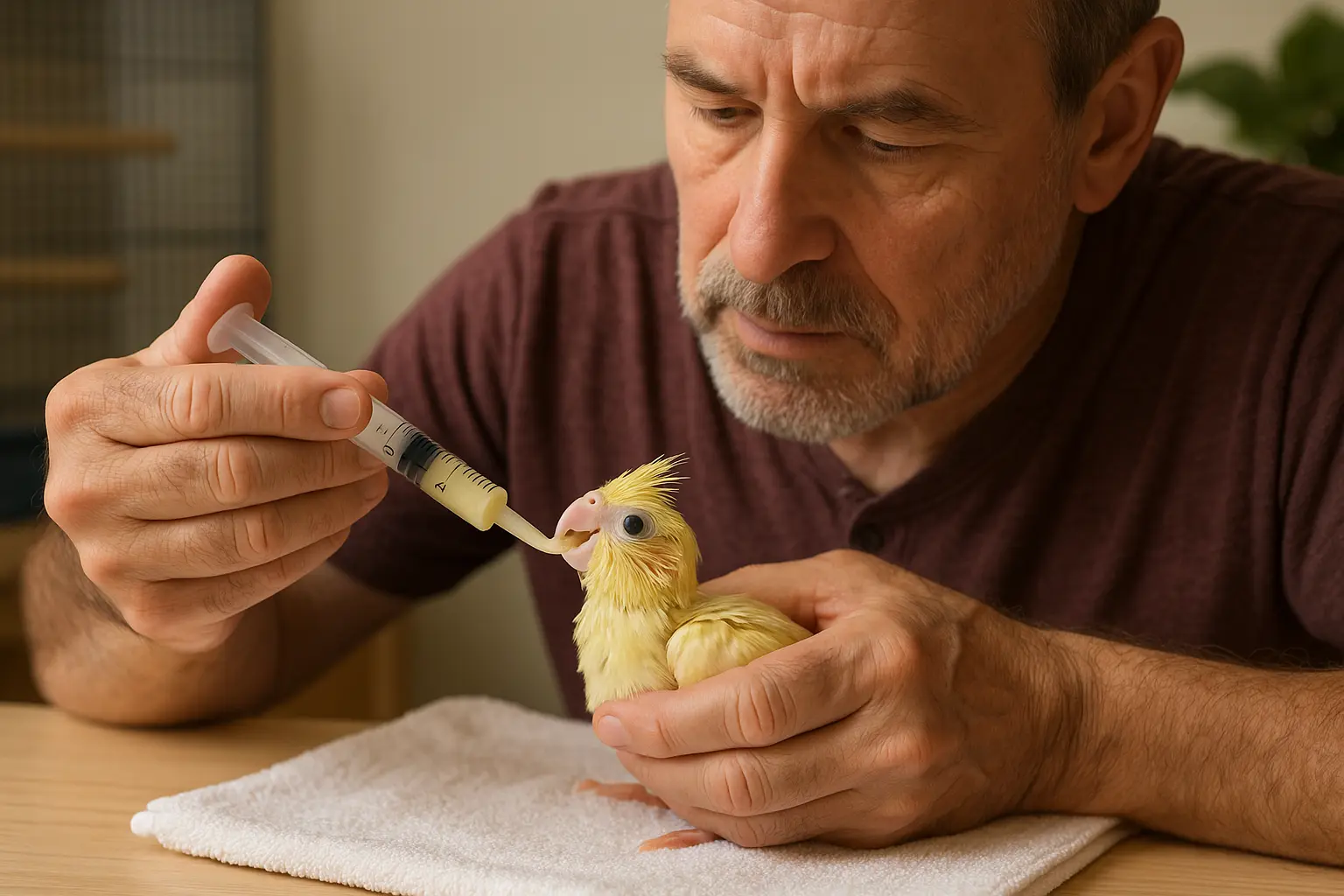How to Hand Feed a Cockatiel: 5 Easy Steps for Beginners
As a cockatiel breeder who has raised hundreds of chicks over the years, I can tell you that learning how to hand feed a cockatiel is one of the most special things you can do. Hand feeding basically means using a syringe or spoon to give warm, soft formula to a baby cockatiel that can’t eat seeds or pellets yet. It is how I care for my youngest chicks and start building a bond with them early on.
Hand feeding is not just about food. It helps baby cockatiels trust humans, makes taming easier, and gives them the best start in life. In this post, I will guide you through 5 simple steps I use every day in my bird room. These tips are beginner-friendly, but they come straight from years of hands-on experience.
What You Need Before You Hand Feed a Cockatiel
Before you begin, it is important to be prepared. I always tell new owners: don’t rush into hand feeding without the right tools and a basic understanding of cockatiel chick behavior. Being ready makes all the difference.
Feeding Tools & Supplies
Here is what I keep on hand when I’m raising baby cockatiels:
Syringe or spoon: I personally prefer syringes with a soft rubber tip for precision and gentleness.
Hand-feeding formula: Only use commercial formulas made for parrots, never use cow’s milk or homemade recipes.
Thermometer: To check the formula’s temperature (I use a digital kitchen one).
Paper towels: For quick cleanups, trust me, you will need them!
Brooder or warm towel: Chicks need warmth to digest food and stay healthy.
Having all these supplies within reach helps prevent stress for both you and the bird.
Understanding Baby Cockatiel Behavior
As a breeder, I watch my chicks closely. A healthy baby cockatiel will make soft begging sounds and open its beak when it’s hungry. They may bob their head a bit too. But if a chick is silent, sleepy, or has a very full crop (the pouch in front of the neck), it is not the right time to feed.
I always wait until the crop is almost empty before offering more formula. If a chick looks weak, fluffs up, or seems to struggle with breathing, I stop feeding and call my avian vet. These signs could mean the chick is sick or stressed.
Step 1: Prepare the Formula Properly
Getting the formula right is a big part of learning how to hand feed a cockatiel. Over the years, I saw people make the mistake of guessing the temperature or mixing it too thick. That can really harm the chick.
Start by following the instructions on your hand-feeding formula exactly. I mix small batches fresh for each feeding. The consistency should be smooth no lumps. I always check the temperature with a thermometer. It should be between 95°F and 105°F. Any hotter can burn the chick’s crop; too cold and they can’t digest it well.
To test it, I put a drop on my wrist, it should feel warm not hot. Never use a microwave. It creates hot spots that can burn your bird.
Step 2: Keep Your Cockatiel Warm and Comfortable
One thing I learned early on: a cold chick will not eat well and can get sick fast. That’s why I always keep my baby cockatiels in a warm brooder. For very young cockatiels, I set the brooder to about 90°F–95°F.
If you don’t have a brooder, wrap the chick gently in a soft towel while feeding. This keeps them calm and prevents too much wiggling. Just make sure the head is free, and never lay them on their back—that’s very dangerous.
Warmth helps with digestion and keeps the cockatiel comfortable during and after feeding. I also keep the room quiet and stress-free. Chicks are sensitive to noise and fast movements.
Step 3: Use the Right Feeding Technique
Over the years, I found that every chick has a slightly different personality. Some take to the syringe easily, others prefer a spoon. The most important thing is to go slow, stay calm, and keep the bird safe.
Syringe vs Spoon Feeding
Here is what I tell new cockatiel owners:
Syringe feeding: Quicker and better for younger chicks. I use a 1 ml syringe for tiny babies and move up to 5 ml as they grow.
Spoon feeding: Slower but gentler. It can feel more natural for slightly older chicks.
Try both and see what works. Always feed from the left side of the beak, aiming the food to the right side of the crop (their natural food pouch).
How to Position the Bird Safely
Wrap your cockatiel in a towel burrito-style with just the head showing. Hold the chick upright in one hand and use your other hand to feed. Never tip the head back, this can cause choking or food entering the airway.
Let the chick cockatiel open its mouth on its own. Gently insert the tip and slowly press the formula in small amounts. Watch their crop, it should fill slowly but not stretch.
How to Hand Feed a Cockatiel: How Much and How Often to Feed
Here is the feeding schedule I use:
0–2 weeks: Every 2–3 hours (6–8 times a day).
2–3 weeks: About 4–5 feedings a day.
3–4 weeks: Down to 3 feedings a day.
5+ weeks: 2–3 feedings a day plus soft solids.
Always wait for the crop to empty before feeding again. I check it by gently feeling the crop with two fingers.
Step 4: Clean Up After Every Feeding
Hygiene is extremely important when hand feeding. Dirty tools or crusty formula on feathers can lead to infections. I always clean right after each meal.
Here’s my routine:
Use a damp, warm cloth to gently wipe formula off the beak and feathers.
Wash syringes and spoons with hot, soapy water.
Rinse thoroughly and let them air dry.
Toss any leftover formula, never reuse it!
Keep your feeding area tidy too. Bacteria can grow fast in spilled formula.
Step 5: Monitor Health and Weight Daily
Every morning, I weigh my chicks before feeding. I use a small kitchen gram scale and keep a notebook for tracking their growth. A healthy chick will gain weight steadily every day.
Watch for warning signs like:
-Crop not emptying
-Odd droppings (watery, smelly, or discolored)
-Weakness or no appetite
-Labored breathing
If I notice anything unusual, I call my vet right away. Quick action can make a big difference.
How to Hand Feed a Cockatiel: Bonus Tips for First-Time Hand Feeders
If you are just starting out, here are a few breeder-tested tips that have helped many of my clients:
-Stay calm. Your bird can sense if you are nervous.
-Don’t rush. Let your cockatiel take their time swallowing.
-Avoid force-feeding. Wait for the chick to open its beak naturally.
-Practice with water first. Learn the technique before using real formula.
-Join a bird group. Forums and Facebook groups are great for support.
Common Mistakes to Avoid When You Hand Feed a Cockatiel
Even experienced breeders make mistakes sometimes. But here are the big ones I warn beginners about:
-Feeding cold or overheated formula
-Not cleaning tools after feeding
-Feeding too often or too soon
-Using cow’s milk or baby food (never do this!)
-Ignoring signs of illness
-Being careful goes a long way in keeping your chick healthy.
As a breeder, I watched tiny, helpless chicks grow into strong, happy cockatiels because of proper hand feeding. Learning how to hand feed a cockatiel takes a little practice, but once you get the hang of it, it becomes second nature.
Just remember: go slow, keep it warm, stay clean, and always follow your bird’s cues. The bond you build through feeding will last a lifetime. And if you ever feel unsure, don’t hesitate to ask a vet or fellow bird lover for help.

